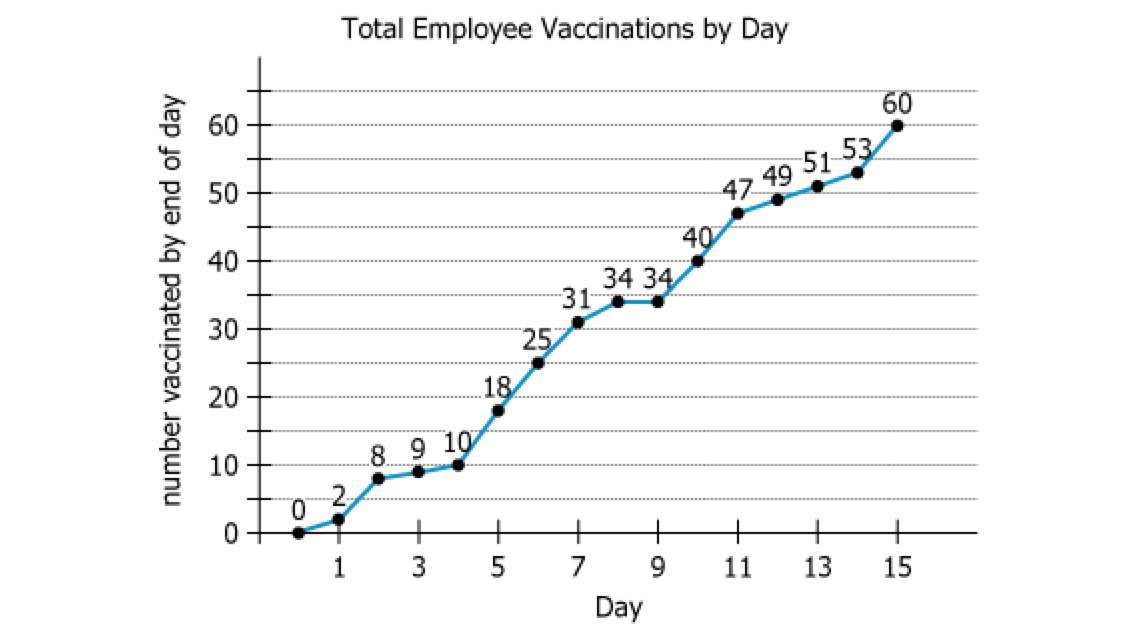Over a 15 day period (Days 1-15), each of the 60 employees of a firm received a certain vaccination. The...
GMAT Graphics Interpretation : (GI) Questions

Over a 15 day period (Days 1-15), each of the 60 employees of a firm received a certain vaccination. The graph shows the total number of employees that had received the vaccination by the end of each of these days.
Based on the information provided, select from each drop-down menu the option that creates the most accurate statement.
Owning the Dataset
Table 1: Text Analysis
| Text Component | Literal Content | Simple Interpretation |
|---|---|---|
| Time period | Over a 15 day period (Days 1–15) | The data covers 15 consecutive days of activity |
| Population | 60 employees of a firm | There are 60 employees total in the group studied |
| Event | Each received a certain vaccination | Each employee was vaccinated once during the period |
| Graph focus | Shows the total number of employees that had received the vaccination by the end of each of these days | The data is presented as a running, cumulative total rather than per-day figures |
Table 2: Chart Analysis
| Chart Component | Displayed Information | Interpretation |
|---|---|---|
| Chart type | Line chart of cumulative vaccinations | Shows running total of vaccinations over time |
| X-axis | Days 0–15 (units = day) | Timeline matches text period; starts at 0 |
| Y-axis | Number of vaccinated employees (0–60) | Max value aligns with population total |
| Data points | Starts at 0, ends at 60 | All employees vaccinated by day 15 |
| Slope patterns | Some days have steep increases, some are flat | Daily vaccinations varied: some days had many, others few or zero |
| Flat lines | No change (e.g. days 8–9) | No vaccinations done on that day |
Key Insights
Vaccinations were not evenly distributed over the 15 days: on some days (such as days 5, 6, 11, and 15), 7 or more employees received the vaccine, while on at least one day (day 9), no vaccinations occurred. The average daily vaccinations is 4, but actual daily counts ranged from 0 to 8. All 60 employees received their vaccinations by day 15, as reflected in the cumulative total reaching the population maximum.
Step-by-Step Solution
Question 1: Average Number of Employees Vaccinated Per Day
Complete Statement:
For this 15-day period, the average (arithmetic mean) number of employees receiving the vaccination per day was [BLANK].
Breaking Down the Statement
- Statement Breakdown 1:
- Key Phrase: 15-day period
- Meaning: The relevant timeframe is 15 days.
- Relation to Chart: The x-axis includes Day 1 through Day 15.
- Important Implications: Any calculation of average should cover all these 15 days.
- Statement Breakdown 2:
- Key Phrase: average (arithmetic mean) number of employees receiving the vaccination per day
- Meaning: Find the total employees vaccinated and divide by number of days.
- Relation to Chart: The chart provides cumulative totals, ending at 60 employees.
- Important Implications: \(\mathrm{Average = Total\ vaccinated / 15}\).
- What is needed: The average daily number of employees who received the vaccination over the 15 days.
Solution:
- Condensed Solution Implementation:
Take the final total number of vaccinations (from the chart) and divide by the number of days (15). - Necessary Data points:
Total employees vaccinated by Day 15: 60. Number of days: 15.- Calculations Estimations:
\(\mathrm{Average\ per\ day = 60 / 15 = 4}\). - Comparison to Answer Choices:
The answer choices include 4, which matches our calculation.
- Calculations Estimations:
FINAL ANSWER Blank 1: 4
Question 2: Days with 7 or More Vaccinations
Complete Statement:
On exactly [BLANK] days of this period, 7 or more employees received this vaccination.
Breaking Down the Statement
- Statement Breakdown 1:
- Key Phrase: exactly [BLANK] days
- Meaning: We are asked for a count of specific days.
- Relation to Chart: Must compute daily vaccination counts from the cumulative data.
- Statement Breakdown 2:
- Key Phrase: 7 or more employees received this vaccination
- Meaning: Count the number of days where at least 7 employees were vaccinated.
- Relation to Chart: Find daily differences between consecutive cumulative totals.
- What is needed: The number of days where daily vaccinations was 7 or higher.
Solution:
- Condensed Solution Implementation:
Calculate daily vaccinations for all 15 days by subtracting previous day's total from current day's total, then count days with 7 or more. - Necessary Data points:
Find days where the difference is 7 or more. For example: Day 5 (8), Day 6 (7), Day 11 (7), Day 15 (7).- Calculations Estimations:
Day 5: \(\mathrm{18-10=8}\) (yes); Day 6: \(\mathrm{25-18=7}\) (yes); Day 11: \(\mathrm{47-40=7}\) (yes); Day 15: \(\mathrm{60-53=7}\) (yes). Total = 4 days. - Comparison to Answer Choices:
Answer choices include 4, which matches the count.
- Calculations Estimations:
FINAL ANSWER Blank 2: 4
Summary
Both blanks require careful interpretation of the information given by the cumulative vaccination chart. Blank 1 is solved by averaging the total over the days. Blank 2 is solved by calculating daily increments and counting those that are 7 or more. Both answers are 4.
Question Independence Analysis
The two blanks are independent. The answer to the first is simply based on total vaccinations and days. The second requires detailed daily analysis but does not depend on the first calculation.